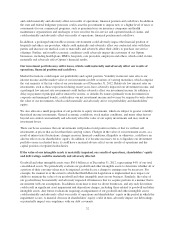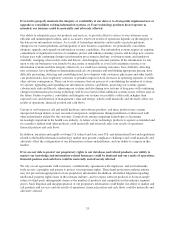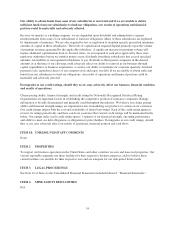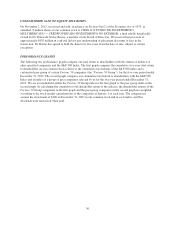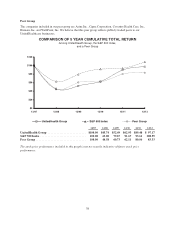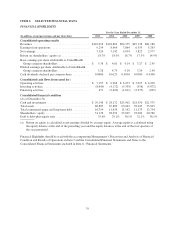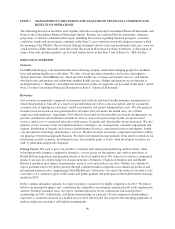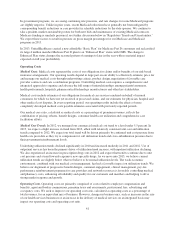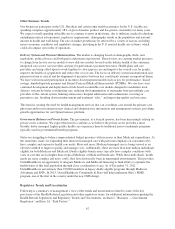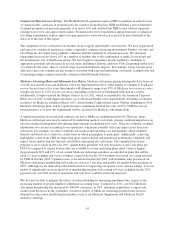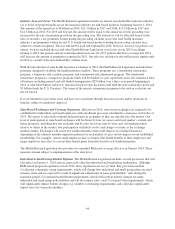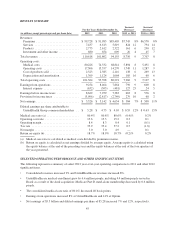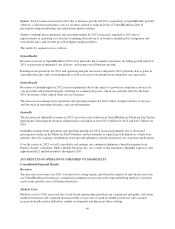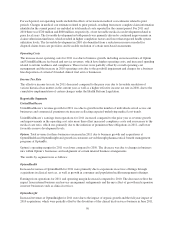United Healthcare 2012 Annual Report Download - page 44
Download and view the complete annual report
Please find page 44 of the 2012 United Healthcare annual report below. You can navigate through the pages in the report by either clicking on the pages listed below, or by using the keyword search tool below to find specific information within the annual report.Other Business Trends
Our businesses participate in the U.S., Brazilian and certain other health economies. In the U.S., health care
spending comprises approximately 18% of gross domestic product and has grown consistently for many years.
We expect overall spending on health care to continue to grow in the future, due to inflation, medical technology
and pharmaceutical advancement, regulatory requirements, demographic trends in the population and national
interest in health and well-being. The rate of market growth may be affected by a variety of factors, including
macro-economic conditions and regulatory changes, including in the U.S. enacted health care reforms, which
could also impact our results of operations.
Delivery System and Payment Modernization. The market is changing based on demographic shifts, new
regulations, political forces and both payer and patient expectations. These factors are creating market pressures
to change from fee-for-service models to new delivery models focused on the holistic health of the consumer,
integrated care across care providers and pay-for-performance payment structures. Health plans and care
providers are being called upon to work together to close gaps in care and improve the overall care for people,
improve the health of a population and reduce the cost of care. The focus on delivery system modernization and
payment reform is critical and the alignment of incentives between key constituents remains an important theme.
We have seen increased participation in incentive-based payment models such as pay for performance, shared
savings, bundled/episode payment and Patient-Centered Medical Home models (PCMHs). We also have seen
continued development and deployment of risk-based accountable care models designed to modernize local
delivery systems by better coordinating care, reducing the fragmentation of treatments between multiple care
providers in the current system, limiting unnecessary hospital admissions and readmissions, focusing on
preventive care, breaking down reimbursement and treatment “silos,” and improving quality and outcomes.
This trend is creating the need for health management services that can coordinate care around the primary care
physician and for investment in new clinical and administrative information and management systems, providing
growth opportunities for our Optum business platform.
Government Reliance on Private Sector. The government, as a benefit sponsor, has been increasingly relying on
private sector solutions. We expect this trend to continue as we believe the private sector provides a more
flexible, better managed, higher quality health care experience than do traditional passive indemnity programs
typically used in governmental benefit programs.
States are struggling to balance unprecedented budget pressures with increases in their Medicaid expenditures. At
the same time, many are expanding their interest in managed care with particular emphasis on consumers who
have complex and expensive health care needs. More and more, Medicaid managed care is being viewed as an
effective method to improve quality and manage costs. Additionally, there are more than nine million individuals
eligible for both Medicare and Medicaid. Dually eligible beneficiaries typically have complex conditions with
costs of care that are far higher than a typical Medicare or Medicaid beneficiary. While these individuals’ health
needs are more complex and more costly, they have historically been in unmanaged environments. This provides
UnitedHealthcare an opportunity to integrate Medicare and Medicaid financing to fund efforts to optimize the
health status of this frail population through close coordination of care. As of December 31, 2012,
UnitedHealthcare served more than 250,000 members in legacy dually eligible programs through Medicare
Advantage and SNPs. In 2013, UnitedHealthcare Community & State will help implement Ohio’s MME
program, one of the first in the country under the new CMS design.
Regulatory Trends and Uncertainties
Following is a summary of management’s view of the trends and uncertainties related to some of the key
provisions of the Health Reform Legislation and other regulatory items; for additional information regarding the
Health Reform Legislation and Regulatory Trends and Uncertainties, see Item 1, “Business — Government
Regulation” and Item 1A, “Risk Factors.”
42


